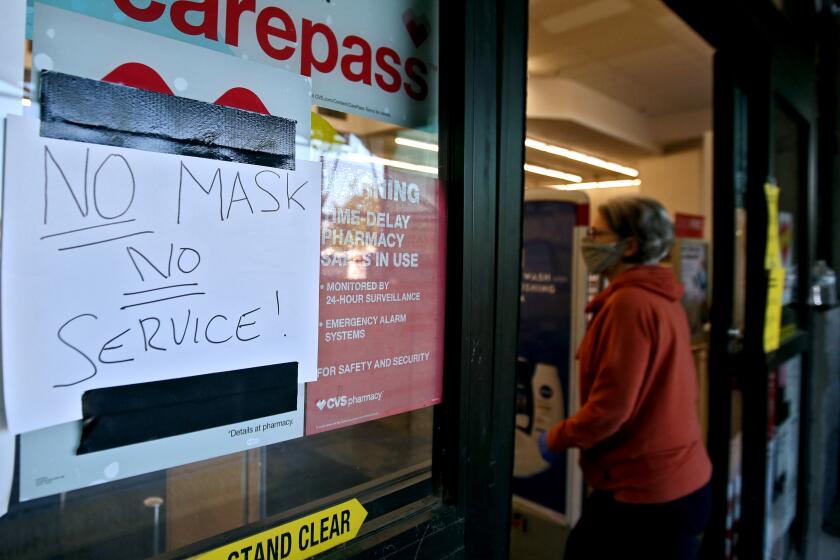Your office is reopening. Do you have to go back? These are your options

Your boss wants you back at the office. But you’re worried.
Maybe coronavirus cases are rising in your area. Maybe you don’t know whether your workplace plans to enforce any safety precautions. Maybe your boss has mentioned the global pandemic in a way that makes you think they aren’t taking it particularly seriously.
For the record:
11:01 a.m. June 29, 2020This article previously referred to the NLRB incorrectly as the National Labor Review Board. It is the National Labor Relations Board.
As offices reopen, employees are trying to figure out how to balance keeping their jobs with not getting themselves or their loved ones sick.
“Workers are scared,” said Irene Tung, senior researcher and policy analyst with the National Employment Law Project. A survey of workers found that many “are going to work even though they believe that they are seriously risking their own health or the health of a family member.”
In California, offices where telework is unavailable are currently allowed to be open. Office-based worksites in Los Angeles County can reopen with safeguards. Many offices are developing plans to phase in bringing back workers, though some are going remote permanently or not expecting anyone back until at least 2021.
Know your rights
There is no federal law that says your employer has to implement certain procedures or restrictions in order to reopen, Tung said, and there’s a patchwork of varying laws at the state and local levels. The guidelines issued by the CDC are just that, not binding rules.
Businesses across the U.S. have begun intensive COVID-19 disinfection regimens, exposing returning workers and consumers to some chemicals that are largely untested for human health, a development that’s alarming health and environmental safety experts.
“Workers have very little recourse if their employers call them back to work. There’s no broad right to refuse hazardous work in this country,” Tung said. “There’s no right to say, ‘I’m not going to perform these job duties because proper protection has not been provided to me.’”
And in most states, if you get sick or injured at work, you can probably only seek remedy through worker’s compensation laws, not by directly suing your employer, according to the National Employment Law Project’s Worker Safety and Health program director Debbie Berkowitz.
“Only in very rare cases can a worker who is injured or killed at work sue an employer,” Berkowitz said via email, adding that the worker has to prove intent to harm, which would be tough when there’s a highly contagious illness going around.
If you have a health condition covered under the Americans With Disabilities Act, you may be granted the ability to work from home as a reasonable workplace accommodation, but it’s not a guarantee.
So legally, you probably have to go back to work. But you still have options.
Ask for details, and come with ideas
For starters, talk to your boss and find out what the plan is. Be diplomatic and use “positive bookends” to frame your inquiry, recommends Lynn Taylor, a workplace expert based in Newport Beach and the author of the book “Tame Your Terrible Office Tyrant: How to Manage Childish Boss Behavior and Thrive in Your Job.” In other words, start on a positive note (something like, “Of course, I’m happy to have a job to go back to, I’m just curious...”) and end on one too (“I’m sure we’re proceeding with everyone’s health and safety in mind, and I know we’ll all navigate this new challenge as a team.”)
In between those bookends, ask for specifics, said Susan Inouye, an executive coach based in Los Angeles.
“Ask them to be clear about the rules they’re going to establish to keep everyone safe. Ask if the team can set up a Zoom time to discuss the rules so that everyone [including] senior managers can hear people’s feedback and ideas, and everyone can feel safe,” Inouye said.
As workplaces reopen amid the coronavirus pandemic, we want to hear from readers.
When you approach your boss, have solutions already in mind. Offer to take the lead in developing the transition plan if there isn’t one already. You can suggest things like temperature checks, limiting the number of people in elevators and meeting rooms, rotating office schedules so not everyone is there at the same time, and making mask wearing mandatory for employees, clients and customers. The Occupational Safety and Health Administration’s guidance on returning to work and the NELP’s resource guide for workers offer more detailed ideas. California’s Department of Industrial Relations has state-specific guidelines.
“Instead of complaining and wondering and being uncertain about what your boss is going to do, ask and propose,” Inouye said. “Say, ‘Look, I was wondering what you’re thinking about because I have some ideas.’”
Push back as a group
If you still don’t feel good about going back, talk to your coworkers. Push back as a group. Coming to your boss and saying, “We have concerns,” is a lot more powerful than saying, “I have concerns.” It also offers you more legal protection from retaliation.
“Joining together with other employees actually gets you more protections under federal law if you’re engaging in protected concerted activities with your coworkers to improve your working conditions,” Tung said. “Then you are theoretically protected also under the National Labor Relations Act; more so than you would be if you were just acting on your own.”
Note the use of the word “theoretically.” Under the Trump administration, funding and staffing have been slashed for both OSHA and the National Labor Relations Board. That leaves many OSHA whistleblower protections “extremely weak and completely unenforced,” Tung said.
Pushing back as a group also protects more vulnerable employees from being singled out for punishment or firing. Black employees are more than twice as likely to be subject to retaliation for raising concerns about coronavirus-related health and safety concerns than white employees, according to a recent NELP study led by Tung — a finding she described as particularly disturbing given how the Black community has been disproportionately affected by the coronavirus.
If you’ve pushed back as a group and your boss still hasn’t budged, that’s the rare occasion that you should consider going over your boss’ head and asking their boss about what to do. If there’s no one above them, or if that person won’t get involved, you have to make a choice about whether it’s worth your health to return to work.
Millions of people around the world might be working from home for a while. Try to enjoy it.
How to ask to work from home forever
Most people who are working from home at this point have been doing it for a while. Though some people are desperate to get back into the office routine, some of us may be realizing we prefer remote work.
Before coronavirus, working remotely full time was a tough sell with a lot of managers. Now, if you want to ask to work from home forever, you can presumably point to three months of stellar productivity and results. Bring evidence of that to your boss.
Taylor, the author and workplace expert, said this is a discussion to have over the phone or a video call, not email or text. Let your boss know you’d like to “discuss your working arrangement” but otherwise keep the topic vague until you’re talking to them directly. Try to anticipate what their objections will be and how you’ll respond.
Come prepared with compromises in mind too. Maybe you could propose working from home for another three months, at which point you’ll both revisit the arrangement. Maybe you’d be happy working from home two or three days a week and coming to the office on the other days.
Make it easy for your boss to say yes. The worst thing they can say is no.
More to Read
Sign up for The Wild
We’ll help you find the best places to hike, bike and run, as well as the perfect silent spots for meditation and yoga.
You may occasionally receive promotional content from the Los Angeles Times.













